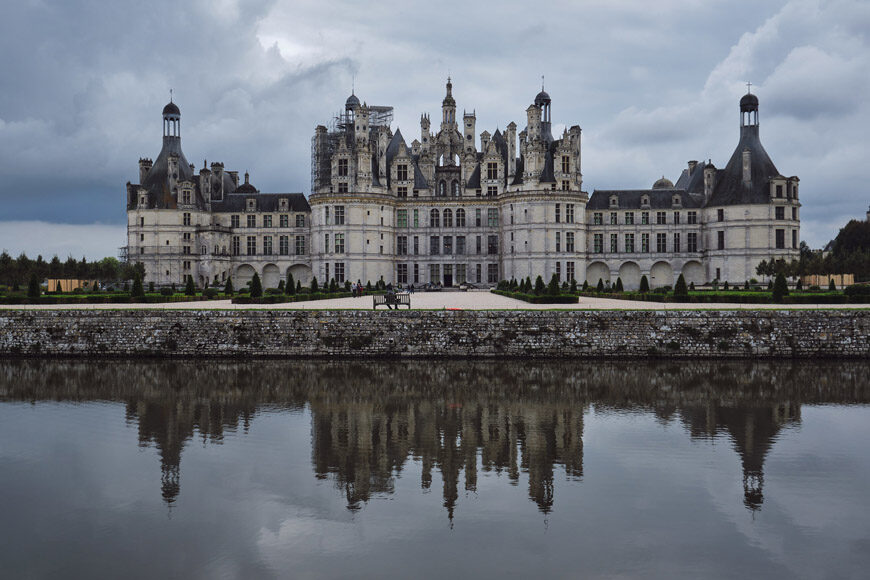Château de Chambord – Chambord Castle
Centre-Val de Loire, France

The Château de Chambord is a Renaissance-style royal castle near Blois, a city in central-northern France, and one of the most popular attractions in the Loire Valley.
Cover image: the northeast facade of the Chambord Castle; photo Angel de Los Rios via Flickr (CC BY-SA 2.0)
History
The castle was commissioned by Francis I of France who wanted to build a sumptuous hunting lodge in a wooden area near the castle of Amboise, where the king had spent his childhood.
Originally, Chambord was not intended as a permanently inhabited residence, it was devised as a hunting game lodge to be used mainly during the warm months, instead. Therefore, the castle was not fully furnished, the furniture was carried from Paris to the castle just for the short periods the king resided in it; furthermore, the royal apartments were uncomfortable in winter, since it was difficult to heat them properly due to their rooms’ height vast size and height. Francis stayed at Chambord for only a few weeks throughout his life and, after him, the castle was inhabited only occasionally until, in the 18th century, it was made more comfortable by adding permanent furniture and improving heating.
In 1930, the French government acquired the castle and opened it to the public after a careful restoration; today, the Château de Chambord is one of the most visited monuments in France, with over 795,000 visitors in 2019.
Chambord Castle, photo Patrick Janicek via Flickr (CC BY 2.0)
Architecture
We don’t know for sure who designed Chambord; many scholars attribute its architecture to Leonardo da Vinci, who died in the nearby Amboise in 1519, mainly because the castle’s design bears many similarities to other architectural projects by Leonardo.
Yet, since all the documents about the castle construction are lost, the design of Chambord has been attributed also to other Renaissance artists, particularly to Italian architect Donato da Cortona. Nevertheless, many agree that at least the castle’s most renowned architectural feature, its famous double-helix staircase, really owes much to Leonardo and was probably designed by him.
The older part of the Château de Chambord is the keep, a large palace with four circular towers at its corners, located at the center of the complex. Completed around 1526, the keep contains the living quarter and several large hallways, with the monumental double-helix staircase in the middle.
The building is topped by an intricate ensemble of highly ornamented chimneys, turrets, and lanterns designed to make the castle look like an idealized version of a medieval fortress, thus echoing that medieval age of chivalry and knighthood that deeply fascinated Francis I as a child.
View of the northeast wing of the Chambord castle from the terrace; photo Benh Lieu Song via Flickr (CC BY-SA 2.0)
The double spiral staircase, allegedly designed by Leonardo, connects all the levels of the keep from the ground floor (the castle doesn’t have a basement) up to a rooftop terrace.
Shaped like a molecule of DNA, the stair consists of two helical ramps twisting one above the other and surmounted by a tall lantern tower; the stair is designed so that when two people use the opposed staircases at the same time, their paths never cross.
The double-helix staircase whose design many scholars attribute to Leonardo da Vinci.
Photo by ‘ho visto nina volare’ via Flickr (CC BY-SA 2.0)
Interior view of the double-helix staircase core; photo Michel Meuleman via Wikimedia Commons (CC BY-SA 4.0)
The central keep is part of a larger compound that comprises an outer enclosure with two bastions and two corner towers – one of which contains the palace chapel – living quarters for the royal court and the staff, warehouses, workshops, stables, and other service facilities.
A moat, realized by partially diverting the course of the Cosson River, borders the mansion on two sides. Finally, French formal gardens and a 5,250-hectare / 13,000-acre park complete the estate.
Visiting Chambord
The castle and its interiors form the main part of the visiting experience. The original Renaissance architecture of the palace was restored in the 20th century and can be fully appreciated by visitors, today; about 60 rooms are currently open to the public.
From an architectural point of view, Chambord is certainly the most spectacular castle in the Loire Valley, and possibly in France.
Inside, the castle is richly decorated and ornamented; many of its rooms are also is fully furnished with pieces dating to the 17th and 18th centuries. Furthermore, the Château de Chambord accommodates a large collection of about 4,500 works of art – including paintings, sculptures, and tapestries – a part of which is exhibited on a rotational basis inside the palace.
The castle’s gardens are among the most popular features of Chambord; they include a beautiful French formal garden, reconstructed in 2017; and a 5250-hectare / 13,000-acre park populated by over 700 red deers.
The Chambord Castle also accommodates two restaurants, four cafes, a wine shop, and a book & gift store.
The king’s ceremonial bedroom; photo Steve Collis via Flickr (CC BY 2.0)
The rooms surrounding the central staircase with three 17th-century tapestries from the Chambord Castle’s permanent collection; photo Javier Valero Iglesias via Flickr (CC BY-SA 2.0)
Chambord castle, corridor, photo moto itinerari via Flickr (CC BY-SA 2.0)
Chambord castle, bird-eye view; photo by Starus via Wikimedia Commons (CC BY-SA 4.0)
How our readers rate this museum (you can vote)
copyright Inexhibit 2025 - ISSN: 2283-5474










